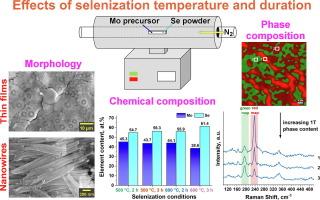当前位置:
X-MOL 学术
›
Appl. Surf. Sci.
›
论文详情
Our official English website, www.x-mol.net, welcomes your
feedback! (Note: you will need to create a separate account there.)
Formation of 2H and 1T/2H MoSe2 via thermal selenization of electrodeposited Mo thin films and nanowires
Applied Surface Science ( IF 6.3 ) Pub Date : 2024-11-15 , DOI: 10.1016/j.apsusc.2024.161801 Daniel Piecha, Mateusz Szczerba, Renata Palowska, Mateusz M. Marzec, Krystian Sokołowski, Tomasz Uchacz, Lifeng Liu, Grzegorz D. Sulka, Agnieszka Brzózka
Applied Surface Science ( IF 6.3 ) Pub Date : 2024-11-15 , DOI: 10.1016/j.apsusc.2024.161801 Daniel Piecha, Mateusz Szczerba, Renata Palowska, Mateusz M. Marzec, Krystian Sokołowski, Tomasz Uchacz, Lifeng Liu, Grzegorz D. Sulka, Agnieszka Brzózka

|
Here, we present how thermal selenization can be used in tandem with electrodeposition to prepare MoSe2-based materials. Mo precursors (thin films or nanowire arrays) were prepared via electrodeposition and thermally selenized at 500/600 °C for 2/3h. Scanning electron microscopy (FE-SEM), X-ray powder diffraction (XRD), energy-dispersive X-ray spectroscopy (EDS), X-ray photoelectron spectroscopy (XPS), and Raman spectroscopy were used to determine the morphology, chemical and phase compositions of materials. The experimental results demonstrated changes in the morphology after selenization, like creation of circular grain domains in Mo films, and partial hollowing and coarsening of Mo nanowires. Selenization of both types of precursors resulted in phase-diverse MoSe2 products: hexagonal (2H) phase for Mo films, and mixture of trigonal and hexagonal (1T/2H) phases in the case of Mo nanowires. EDS measurements revealed that the Se content in Mo-Se films varied from 4.6 to 26.5 at.%, while in Mo-Se nanowires, it ranged from 54.7 to 61.4 at.%, which indicates that thermal selenization was more effective when the precursor was in the form of nanowires. This study suggests the potential to control parameters in the thermal selenization process such as substrate selection, temperature, and duration to develop innovative MoSe2-based electrodes for more efficient energy-related applications.
中文翻译:

通过电沉积 Mo 薄膜和纳米线的热硒化形成 2H 和 1T/2H MoSe2
在这里,我们介绍了如何将热硒化与电沉积结合使用来制备 MoSe2 基材料。通过电沉积制备 Mo 前驱体(薄膜或纳米线阵列),并在 500/600 °C 下热硒化 2/3 h。采用扫描电子显微镜 (FE-SEM)、X 射线粉末衍射 (XRD)、能量色散 X 射线光谱 (EDS)、X 射线光电子能谱 (XPS) 和拉曼光谱确定材料的形貌、化学和物相组成。实验结果表明,硒化后形态发生了变化,例如在 Mo 薄膜中产生圆形晶畴,以及 Mo 纳米线的部分空心和粗化。两种前驱体的硒化产生了相差的 MoSe2 产物:Mo 薄膜为六方 (2H) 相,Mo 纳米线为三方和六方 (1T/2H) 相的混合物。EDS 测量显示,Mo-Se 薄膜中的 Se 含量在 4.6 到 26.5 at.% 之间变化,而在 Mo-Se 纳米线中,它在 54.7 到 61.4 at.% 之间,这表明当前驱体为纳米线形式时,热硒化更有效。这项研究表明,有可能控制热硒化过程中的参数,如基板选择、温度和持续时间,以开发基于 MoSe2 的创新电极,以实现更高效的能源相关应用。
更新日期:2024-11-15
中文翻译:

通过电沉积 Mo 薄膜和纳米线的热硒化形成 2H 和 1T/2H MoSe2
在这里,我们介绍了如何将热硒化与电沉积结合使用来制备 MoSe2 基材料。通过电沉积制备 Mo 前驱体(薄膜或纳米线阵列),并在 500/600 °C 下热硒化 2/3 h。采用扫描电子显微镜 (FE-SEM)、X 射线粉末衍射 (XRD)、能量色散 X 射线光谱 (EDS)、X 射线光电子能谱 (XPS) 和拉曼光谱确定材料的形貌、化学和物相组成。实验结果表明,硒化后形态发生了变化,例如在 Mo 薄膜中产生圆形晶畴,以及 Mo 纳米线的部分空心和粗化。两种前驱体的硒化产生了相差的 MoSe2 产物:Mo 薄膜为六方 (2H) 相,Mo 纳米线为三方和六方 (1T/2H) 相的混合物。EDS 测量显示,Mo-Se 薄膜中的 Se 含量在 4.6 到 26.5 at.% 之间变化,而在 Mo-Se 纳米线中,它在 54.7 到 61.4 at.% 之间,这表明当前驱体为纳米线形式时,热硒化更有效。这项研究表明,有可能控制热硒化过程中的参数,如基板选择、温度和持续时间,以开发基于 MoSe2 的创新电极,以实现更高效的能源相关应用。


















































 京公网安备 11010802027423号
京公网安备 11010802027423号